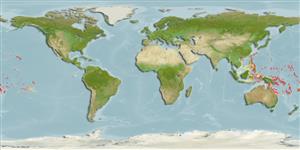Classification / Names
Common names from other countries
Main reference
Size / Weight / Age
Max length : 10.6 cm SL male/unsexed; (Ref. 529)
Length at first maturity
Lm ?, range 6 - ? cm
Environment
Marine; reef-associated; depth range 0 - 8 m (Ref. 529)
Climate / Range
Tropical, preferred ?; 27°N - 25°S
Distribution
Pacific Ocean: southern Taiwan to Tuamoto Islands, south to Tonga; throughout Micronesia.
Countries | FAO areas | Ecosystems | Occurrences | Introductions
Short description
Dorsal
spines
(total): 12;
Dorsal
soft rays
(total): 13-15;
Anal
spines: 2;
Anal
soft rays: 14 - 16;
Vertebrae: 30. Diagnosis: Dorsal fin XII, 14, membrane attached to caudal fin, with deep notch above last spine, first spine almost same or slightly higher than second; anal fin II, 15; pectoral rays 15; pelvic fin I, 4; caudal fin procurrent rays 11-14. Vertebrae 10 + 20. LL, without scales and scalelike flaps; LL tubes 0-3 (sometimes up to 5), canal ends below 13th dorsal spine to caudal-fin base. Upper lip crenulae 40-55. Gill rakers 22-32. Cephalic sensory pore system complex. Cirri: supraorbital 18-42 (usually 20-37); nasal 7-32 (usually 11-27); nuchal 47-66 (usually 50-60), in 4 groups with 2 or more sometimes connected basally by a frenum, dorsalmost groups usually meet or overlap at midpoint on nape, ventralmost group on each side borne on broadly expanded flap. Head with dark brown spots on pale background; orangish red iris; yellow pelvic fins; pectoral fins spotted on proximal half. (Ref. 529).
IUCN Red List Status (Ref. 115185)
Threat to humans
Harmless
Human uses
Fisheries: of no interest
More information
ReferencesAquacultureAquaculture profileStrainsGeneticsAllele frequenciesHeritabilityDiseasesProcessingMass conversion
Tools
Special reports
Download XML
Internet sources
Estimates of some properties based on models
Phylogenetic diversity index
PD50 = 0.5000 many relatives (e.g. carps) 0.5 - 2.0 few relatives (e.g. lungfishes)
Trophic Level
2.0 ±0.00 se; Based on food items.
Resilience
High, minimum population doubling time less than 15 months (Preliminary K or Fecundity.)
Vulnerability
Low to moderate vulnerability (26 of 100)
Price category
